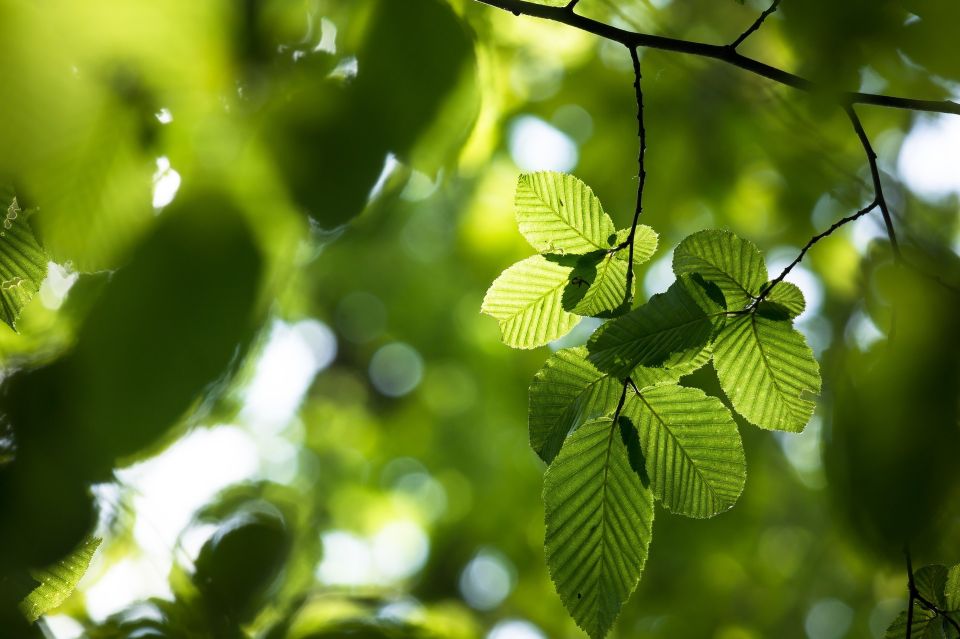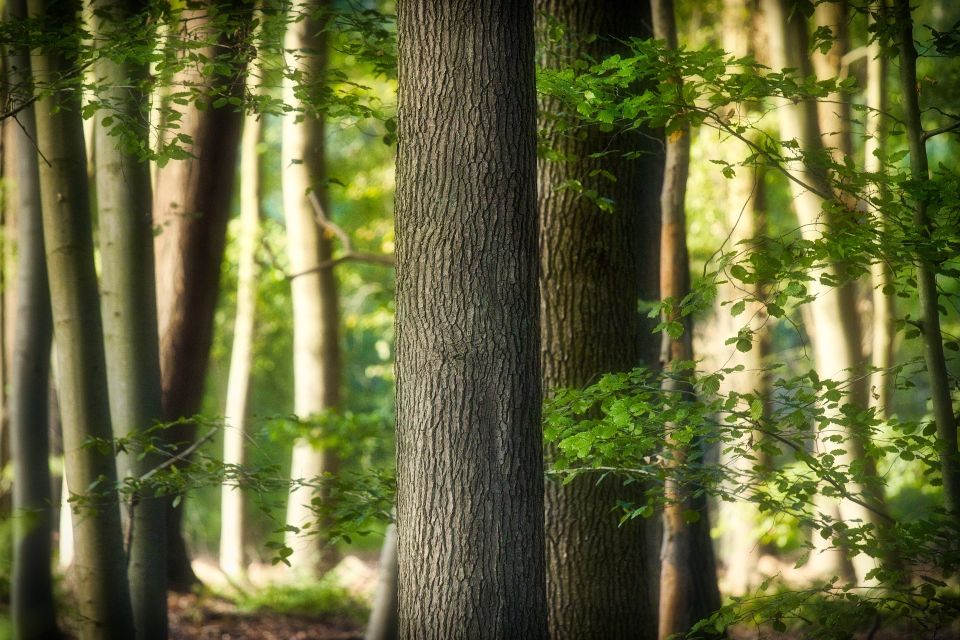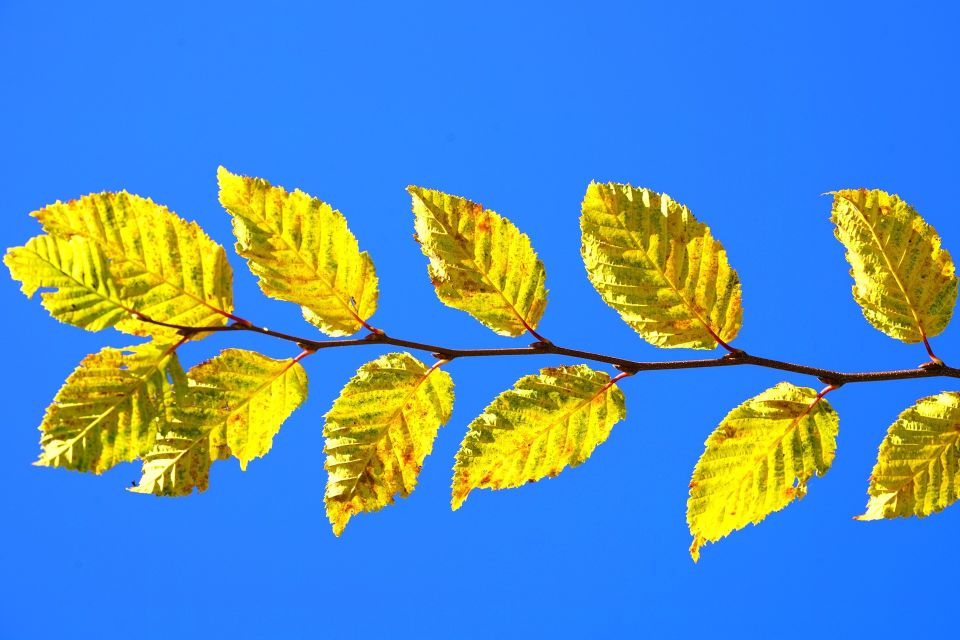Intreeducing: The Beech

Intreeducing her highness the majestic Beech, wise and learned Queen of the forest.
Latin name: Fagus sylvatica
I can tell when I enter a grove or forest of beech trees, the light itself changes. It has a unique atmosphere, sun dappled and spacious. The graceful smooth boughs arching up higher and higher till they meet to form a gothic green leafy ceiling. Autumn gilds them with a golden festive air and the leaves bronze the floor and sky like glinting confetti, tall slender trunks contrasting darkly against the gold. On a sunny day this is spectacular against a bright blue sky.
Some say cathedral builders were inspired by the beauty and structure of beech woods to build their own high vaulting arches. And I can see why. Beech was thought of as the Mother of the Woods and known as the Beech Queen whose consort is the Oak King. And she really is majestic.
How to spot it
Beech is a large deciduous tree with smooth grey bark and can grow to a height of 40 metres. It develops a domed crown which spreads out into a dense canopy. Beech trees are monoecious which means they have male and female flowers on the same tree. These catkin flowers grow in April and May, male flowers are yellow, outlined in red–they hang as catkins from the branches. Female flowers are yellow and arranged in pairs. They are wind pollinated.
The leaves are oval with wavy edges, pale green in colour when young, and mid to dark green when mature. The leaves are 5-15 cm long, and 4-10cm broad. In the Autumn the beech gives a spectacular display of rich yellow and orange brown leaves.
In autumn beech develops bristly triangular seed pods which fall and open to reveal nut like seeds known as ‘mast’, and which are distinctively 3-sided. The opened pods often remain on the tree long after the seed has fallen. The crackly, bronze dead leaves often remain right through winter, especially on young trees, which are not prey to high winds. In late winter, Beech trees are identifiable by their alternate slender bronze buds ready to develop on zigzagging twigs.
Beech trees can develop into giants which tower over all other woodland trees and can live to 300 years. But when coppiced they can live for more than 1,000 years.
Hedge
Beech has another side to it and can also be grown as a hedge which is a popular use. When grown this way and trimmed in the summer it can keep its leaves in a dry state giving a lovely bronze earthy colour throughout winter. It provides a year-round dense screen, which is a great habitat for garden birds. The tallest and longest hedge in the world, 530 metres long and 36.6 metres high is the Meikleour Beech Hedge in Meikleour, Scotland.
Planting of beech woods and the great storm
Historically, Beech trees were native in southern England and south Wales; elsewhere it was always originally planted, although it now grows wild throughout the country. Though beech trees grow well on chalk and light soils, windbreaks of mature beech can be seen growing high in the Derbyshire Peak District and in lowland river valleys. Beech saplings are also steely growers, enabling them to thrive on poor soil. They blanket parts of the Chilterns, the South Downs and the Cotswolds.
Much of what now seems like ancient beech woodland were actually planted by man quite recently. The great beech forests of the Chilterns were almost entirely planted in the 18th century. It became fashionable for Beech trees to be planted in the grounds of private estates of wealthy landowners in the 17th/18th centuries because of their stately aspect.
In the great storm of 1987 which hit southern England, about 15 million trees were blown down, beech trees took the brunt and thousands of mature trees were felled. In the areas of Britain that experienced the worst of the winds –the South-east – the beech was the hardest hit tree of all; by weight, 40 per cent of all fallen timber was beech. Their roots are shallow, so that can make them more vulnerable to the elements.
In their place, other species, often fast-growing trees like sycamore and ash have taken over beech woods, as a lack of management has prevented a restocking of beech. Beech trees may have shallow roots but they have some coping strategies. If one is uprooted, it can produce new shoots, phoenix-like, from a seemingly ruined root system. Tree populations can also cope with strong winds because many of the more elderly ones are hollow, their insides long rotted away; this dramatically reduces their centre of gravity.

Pannage, or pig food
The ground at this time of year is layered with leaves and old beech nuts and their casings, a sure sign that there is a beech tree around. Often, it’s the crunching of beech mast underfoot that makes me look up and spot the beech nearby. These are the tree’s nuts and used to be fed to pigs back in ancient times. In the Middle Ages, this feeding was institutionalized in the practice of pannage, feeding pigs on acorn and beech mast in the autumn in exchange for a fee, often as an in-kind payment. By feeding on the crop of oak acorns or, beechnuts, the young pigs would be ready for slaughter in December.
For 60 days every autumn this tradition continues to this day in the New Forest, when hundreds of pigs are let loose to forage on the acorns and beech mast. An ancient practice virtually extinct outside the New Forest. This former royal hunting ground entitles locals to release their animals into the forest to gorge on fallen acorns, beech mast and chestnuts and they can stay out for days and weeks on end if there are rich pickings to be found. It’s nature’s own health and safety scheme – the pigs safely scoff as many acorns as they like, clearing the area for the ponies and cattle that can poison themselves if they eat too many – 90 New Forest animals died during the bumper 2013 acorn season.
Human food
It’s not just pigs and huge numbers of birds and mammals that feed on beech mast, humans have also made use of it in the past. In hard times the tiny kernels have been eaten and being high in fat, oil was also extracted and used for cooking and lighting. Collecting sufficient amounts and processing to make it edible can be fiddly and not worth the effort, but every 5 to 10 years is a mast year where there is a huge abundance of the nuts and then it may have been worthwhile to harvest and eat these nutritious little kernels. There is an eighteenth-century reference to the kernels being put in soups. Another old source comments that suitably treated they could be turned into bread. During times of starvation it was a lifeline for the poor. In France they still roast and grind it to use as a coffee substitute.
Books Beech has not only fed us in the past but also provided us with learning. Some of the first books were slices of beech with writing carved on them. Language reflects this connection between beech and books. The English word ‘book’ is derived from the Old English boc. German, a close relative of English, uses “buche” for beech, which later became “buch” (book); “buchstabe” is the word for alphabet. Finally, “bok” in Swedish refers to both the beech and a book. Woven into our very language is this deep connection to the Beech.
Keeping leaves There is an intriguing answer to why some of the beech trees keep their dry leaves through winter. There are many theories but the prominent one is that it all comes down to sex. That is, beech trees are more likely to keep their leaves when they are immature. You know when beech trees are mature when they start flowering. Depending on the species and growing conditions, a tree may not reach maturity for a few years to a few decades, or 40-60 years for beech trees!
Wild life
You might notice there’s more space on the ground under mature beech tree woodland, less undergrowth or lower storey as it’s called. This is because many plants find it difficult to grow in a beech forest because it’s so shady. Species, such as birch and oak, do not get the sunlight they need to grow high around it. But there are some plants, now becoming rare, that have adapted specifically to these conditions and thrive there. Beech woods are not only beautiful but an important habitat.
Beech mast is a favourite food of many woodland animals such as badgers, deer, mice, squirrels and birds. Rare plants such as the birds nest orchid grow in the leaf litter. The leaves are eaten by caterpillars, including those of the lobster moth, the barred hook-tip, clay triple-lines and olive crescent and least black arches.
Other rare plant species associated with beech woodland are box, coralroot bitter-cress, and a variety of orchids including red helleborine. Beech woodland makes an important habitat for many butterflies, particularly in open glades and along woodland rides.
Native truffle fungi grow in beech woods. These fungi are ectomycorrhizal, which means they help the host tree obtain nutrients in exchange for some of the sugar the tree produces through photosynthesis. Because beech trees live for so long, they provide habitats for many deadwood specialists such as hole-nesting birds and wood-boring insects. The bark is often home to a variety of fungi, mosses and lichens.

Other Uses
Beech can be a very tall, straight tree, and the wood is very dense, light-colored, and thick. It has one of the widest ranges of uses: from culinary to artistic to practical. Beech wood is often used to make drums and handles on guns and other tools. Beech wood is used in preparing foods or beers—in some parts of Europe, beech is used to smoke sausages or other meats and beech wood may be used to smoke and dry out malt for beers. In the USA, even major beer manufacturers use beech as a “fining” agent near the end of the brewing process for flavour enhancement. A type of rayon fabric called “modal” is made from the chemically processed and spun cellulose fibres of the beech tree.
Artists, particularly those in the 17th and 18th centuries—including Rembrandt, Lorrain, Cozens, and Gainsborough—used beech soot mixed with water to make a transparent ink/pigment called “soot brown”, or bistre. The soot was gathered from a chimney after burning beech wood, and then mixed with water, and later diluted with water for whatever effect the artist wanted. The colour is dark grey-brown with a hint of yellow.
People for centuries have used beech for graffiti, the bark is thin and smooth and lends itself to being carved. As it can’t fully heal itself those initials and hearts people have cut in can stay for centuries. But it’s not something to be recommended as it can leave the tree open to infection.
Folklore Beech groves have been found in and near important places of power. In Celtic mythology, Fagus was the god of beech trees and he lends his name to the genus of the tree’s Latin name, Fagus sylvatica. Beech was also thought to have medicinal properties – beech leaves were used to relieve swellings, and boiling the leaves could make a poultice. It was thought to be helpful in various skin conditions. Forked beech twigs are also traditionally used for divining.
Wishes were carved into pieces of beech wood and buried to make them manifest. Beech was also used as a good luck charm, and pieces of it were thought to bring good fortune to the wearer.
So there you have it, what a splendid tree she is, truly the Queen of the forest and generous in her bounty. Make time to go pay your respects and revel in her golden glory.
Donate to Trees for Cities and together we can help cities grow into greener, cleaner and healthier places for people to live and work worldwide.
Donate